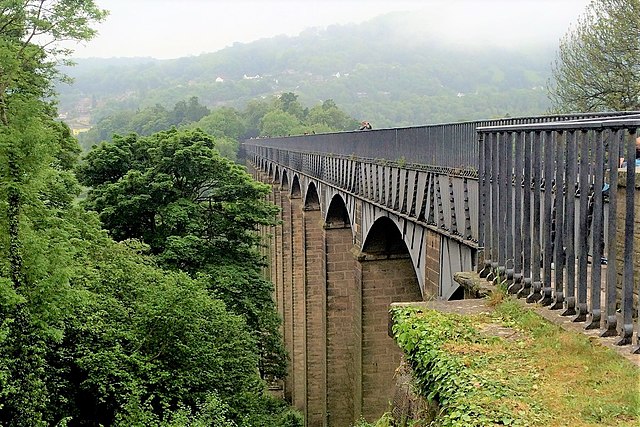Pontcysyllte Aqueduct and Canal: A Marvel of 19th-Century Engineering
Introduction
Nestled in the picturesque landscapes of north-eastern Wales, the Pontcysyllte Aqueduct and Canal stand as a testament to the ingenuity and innovation of the Industrial Revolution. This 18-kilometer-long marvel of engineering, completed in the early 19th century, defied geographical challenges and showcased bold solutions in civil engineering. This blog will delve into the history, construction, and significance of the Pontcysyllte Aqueduct, a UNESCO World Heritage Site that inspires admiration worldwide.

Image by Llywelyn2000, CC BY-SA 4.0 https://creativecommons.org/licenses/by-sa/4.0, via Wikimedia Commons
A Triumph of Engineering
The Pontcysyllte Aqueduct, pronounced [ˌpɔntkəˈsəɬtɛ] in Welsh, is a navigable aqueduct that gracefully carries the Llangollen Canal across the River Dee in the Vale of Llangollen. This remarkable structure, composed of 18 arches constructed from stone and cast iron, was completed in 1805 after a decade of meticulous planning and construction. At 12 feet (3.7 meters) wide, it ranks as the longest aqueduct in Great Britain and the highest canal aqueduct globally. A footpath runs alongside the watercourse, giving visitors a unique perspective of this engineering marvel.

Image by Arpingstone, Public domain, via Wikimedia Commons
A Vision for Connectivity
Originally conceived as a critical component of the Ellesmere Canal, the aqueduct facilitated a commercial link between the River Severn at Shrewsbury and the Port of Liverpool on the River Mersey. Despite a more cost-effective alternative route to the east, the decision was made to traverse the Vale of Llangollen, rich in coalfields. However, only segments of the canal were completed, with significant construction activities halting after the aqueduct's completion in 1805.

Image by Douglal, CC BY-SA 4.0 https://creativecommons.org/licenses/by-sa/4.0, via Wikimedia Commons
A Monument to Progress
The Pontcysyllte Aqueduct is a Grade I listed building and is an integral part of the UNESCO World Heritage Site. Its name, "Pontcysyllte," translates to "Cysyllte Bridge" or "Bridge of Cysyllte" in Welsh, referencing the adjacent township. Contrary to modern misconceptions, it does not mean "bridge of the junction" or "bridge that links."
Design and Construction
Designed by renowned civil engineers Thomas Telford and William Jessop, the aqueduct was initially intended to include a series of locks. However, Telford's innovative approach created an uninterrupted waterway, defying public scepticism. The ironwork for the aqueduct was supplied by William Hazledine from foundries in Shrewsbury, costing approximately £47,000 at the time. Today, this would be equivalent to around £4,060,000.
The aqueduct officially opened to traffic on November 26, 1805, and its impressive 336-yard (307-meter) length, supported by iron arched ribs, quickly became a symbol of engineering excellence.
Thomas Telford

Image from Public domain, via Wikimedia Commons
- Born: August 9 1757, Glendinning, Westerkirk, Eskdale, Dumfriesshire, Scotland
- Died: September 2 1834 (aged 77) in Westminster, London, England
- Occupation: Engineer
Engineering Career
- Discipline: Civil
- Institutions: Founder and first President of the Institution of Civil Engineers (1818)
- Projects
- Caledonian Canal, Göta Canal, Ellesmere Canal, Pontcysyllte Aqueduct, Shrewsbury Canal, Menai suspension bridge, A5 road.
William Jessop

Image from Public domain, via Wikimedia Commons
- Born January 23 1745, Devonport, Plymouth, United Kingdom
- Died November 8 1814 (aged 69)
- Butterley Hall, Ripley, Derbyshire, United Kingdom
- Occupation Civil Engineer
Known for His Work on Canals, Cromford Canal, West India Docks Oxford Canal, Grand Canal (Ireland), Dublin
Challenges and Adaptations
While the aqueduct's completion was a significant achievement, the plan to extend the canal to Moss Valley, Wrexham, was abandoned in 1798 due to financial constraints. Subsequently, the Plas Kynaston Canal was constructed to serve local industry, contributing to the region's economic development.
PKC Plas Kynaston Canal
A Twentieth-Century Renaissance
In the early twentieth century, commercial traffic on the canal declined, culminating in its formal closure under the London Midland and Scottish Railway Company Act of 1944. However, the aqueduct's role as a water feeder and drinking water supplier secured its preservation. In the latter half of the twentieth century, leisure boating traffic thrived.
Maintenance and Preservation
Every five years, the ends of the aqueduct are temporarily closed, and a plug is opened to drain the canal water for inspection and maintenance. This meticulous care ensures the aqueduct's continued operation and preservation.
UNESCO World Heritage Site
In 2009, the Pontcysyllte Aqueduct and Canal were inscribed as a UNESCO World Heritage Site, acknowledging their cultural and historical significance. The aqueduct's enduring legacy as a triumph of engineering and a source of inspiration for generations is now formally recognized globally.
Conclusion
The Pontcysyllte Aqueduct and Canal are more than just a historic landmark; they are a testament to human creativity, determination, and the spirit of innovation. This engineering marvel, standing proudly for over two centuries, continues to awe and inspire visitors worldwide. As we celebrate its UNESCO World Heritage status, let us also celebrate the ingenuity and dedication of those who made this remarkable feat of engineering possible.
https://www.ice.org.uk/what-is-civil-engineering/what-do-civil-engineers-do/pontcysyllte-aqueduct
Leave a Reply